
Cameras and lenses ready for a road trip / Rebecca Latson
How many of you national park camera toters have changed your mindset about one or more aspects of photography, cameras, lenses, camera packs, or travel over the years? I know I have! Nothing proves that for me more than re-reading selected articles I’ve written for the Traveler over the last 11 years.
By the time you read this, I’ll be driving around South Dakota and parts of Wyoming and Montana, photographing at Badlands and Wind Cave national parks, Jewel Cave and Devils Tower national monuments, Minuteman Missile National Historic Site, and a portion of the Ice Age Floods National Geologic Trail in Missoula, Montana. Originally planned for the first week of April, family responsibilities dictated a later departure, which worked to my advantage in a few instances (staying at an in-park lodge now open for the season, scheduling a now-available Minuteman Missile site tour, and reserving a previously unavailable cave tour). The date change, however, threw a wrench in my writing plans, since I intended publishing a column this month about my Midwest road trip. Then, the “idea lightbulb” flicked on.
During the early part of my tenure with the Traveler, I suffered a bout of writer’s block which seemed to last far too long, causing some despondency on my part regarding my writing capabilities. Traveler editor Kurt Repanshek offered to help, sending a few interview questions my way resulting in this 2013 interview article. I re-read that article and realized several answers have changed with the times. I thought the questions might be worth a revisit.
NPT: Do you lament the disappearance of film and/or do you prefer digital cameras over film?
This answer remains the same. I personally do not lament the disappearance of film (it’s still around, folks, just not quite as popular as digital “film”). I will admit, though, the first time I’d ever heard of a digital camera, I wondered who the heck would ever want one of those? Hah! The moment I first looked at the simple LCD on the back of my HP-brand 2mp point-and-shoot to see the exposure results of my very first image with that camera was the moment I never looked back to film. With a digital camera, I don’t need to wait for a commercial printer to process my images to find out whether I nailed (or really screwed up) the exposure settings. I can see it all right away and immediately make the necessary corrections. I can do my own “developing,” and the resolution on these recent-model cameras produce eye-popping images.
NPT: Besides your camera body, what is the most crucial item you ensure you take on your national park treks?
That answer is the same now as in 2013. A zoom lens for my camera body. I do like prime lenses, but a zoom lens is more versatile and if I am required to pare down my equipment for a trip, then that’s what I pack. Now, if the question had been worded slightly differently (“besides camera body and lens” as opposed to just “besides camera body”), I would say a tripod is the most crucial item. I can’t capture amazing night sky shots without a tripod, nor can I capture silky water images or create a timelapse video. I also can’t capture a decent multi-image panorama, nor two exact same shots with different focus points to blend into a single focused shot, foreground to background. Plus, that tripod sure comes in handy as a hiking stick to steady me over uneven ground.
NPT: What do you think of the advent of smartphones with built-in cameras? Good or bad for photography?
I almost laughed out loud re-reading my 2013 answer. Oh my, how things have changed over 11 years! I recently upgraded to an iPhone 15 Pro Max and I just love it! Sure, its sensor is quite small for the maximum megapixel count Apple says it produces (compared to a dedicated, high-MP mirrorless SLR with a larger sensor). That aside, my smartphone captures amazing stills and videos. Can you believe, a cell phone does this! Heck, I use my smartphone for almost all my short videos. It captures nice color and light and I’ll be using it during my cave tours, since I can’t take a tripod with me and don’t want to carry along an SLR and lens and attached flash unit. On a side note, I’ll also take one of my tried-and-true point-and-shoot cameras with me on these tours because of its pop-up flash and ease of use. I can then compare phone vs. P&S images.
NPT: Are smartphone cameras and the miniature video cameras (think GoPro) diminishing the skills needed for photography, or are they opening opportunities for recording national park visits?
Again, what a change in my mindset since 2013. Smartphones and action cameras like GoPro open so many options for photographers. Rather than diminishing, I believe they add to a photographer’s existing skill set. I’m always impressed by what I see produced from these non-standard (i.e. non-SLR-type) cameras.
NPT: When you sit down to plan your next national park trip, what do you consider in deciding which park to visit?
There are so many variables I apply when deciding what unit of the National Park System to next visit. Parks I’ve never seen are top of the list. While the Traveler editor may already have visited the parks in which I’ll be photographing, they are still new to me and it’s nice to write about these visits from the perspective of a first-timer.
From that park list, I look at distances from my home. Distance plus timeframe determines whether I drive or fly. I also compare plane ticket / car rental costs versus gasoline and wear-and-tear using my own vehicle. Last but not least, I look at area lodging availability or whether I might need to reserve a campsite.
Of course, a personal preference as to what I’d like to see plays a huge part in park choice, too. I’m a mountain gal, so I tend to gravitate toward Western and Southwestern park units. If, however, I’m going to visit a park for a specific reason, such as autumn leaf color, I read reviews from “leaf peepers” who have previously visited certain parks, then apply these other variables (distance, cost, personal preference) and plan accordingly.
NPT: Is there any one park that you return to (or would return to time and again) and why?
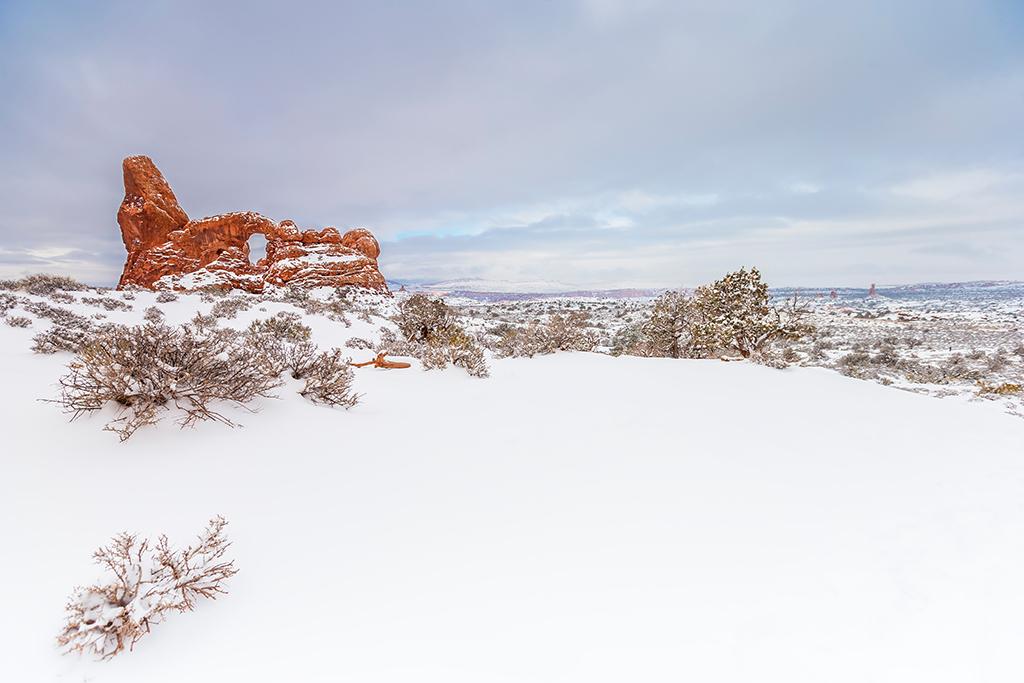
Turret Arch on a snowy winter day, Arches National Park / Rebecca Latson
In the 2013 article, I named Arches National Park in Utah as that return-to park. While I still love that red-rock national park, my favorite parks have changed over the years. At present, there are three parks I would return to time and again: Mount Rainier, Yellowstone, and Death Valley national parks.
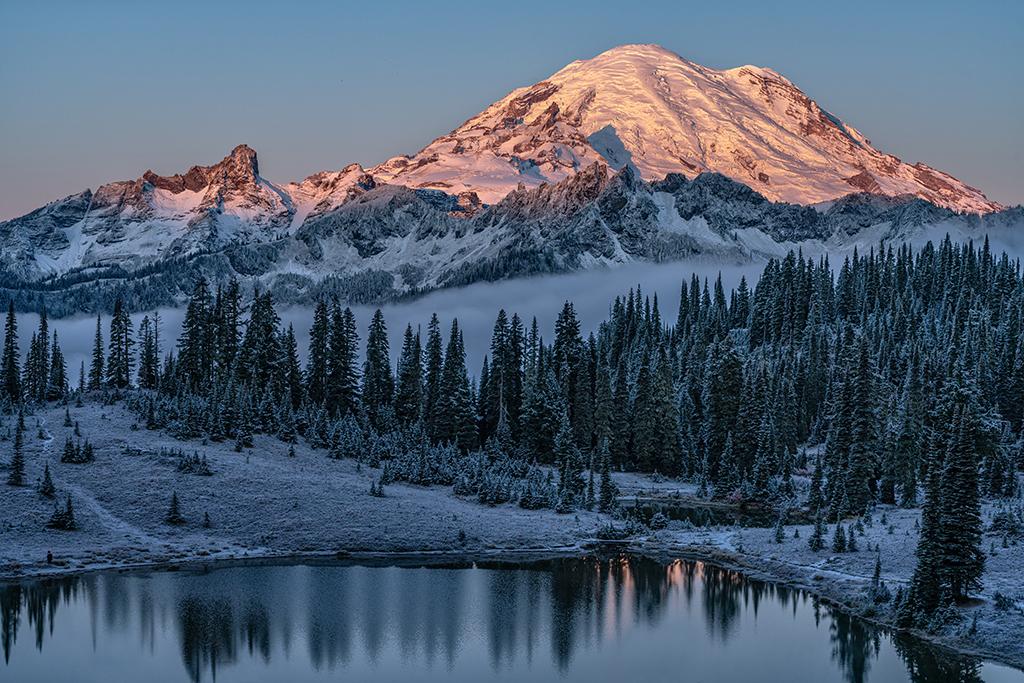
A frosty sunrise over "The Mountain" and Tipsoo Lake, Mount Rainier National Park / Rebecca Latson
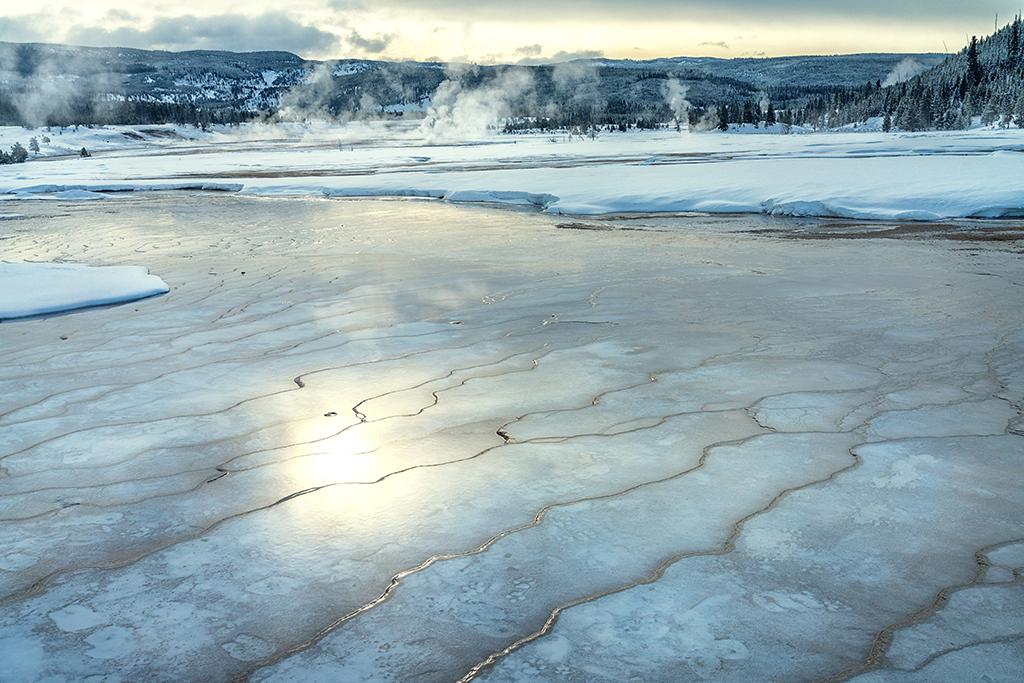
Reflections and footprints on the Midway Basin terraces, Yellowstone National Park / Rebecca Latson
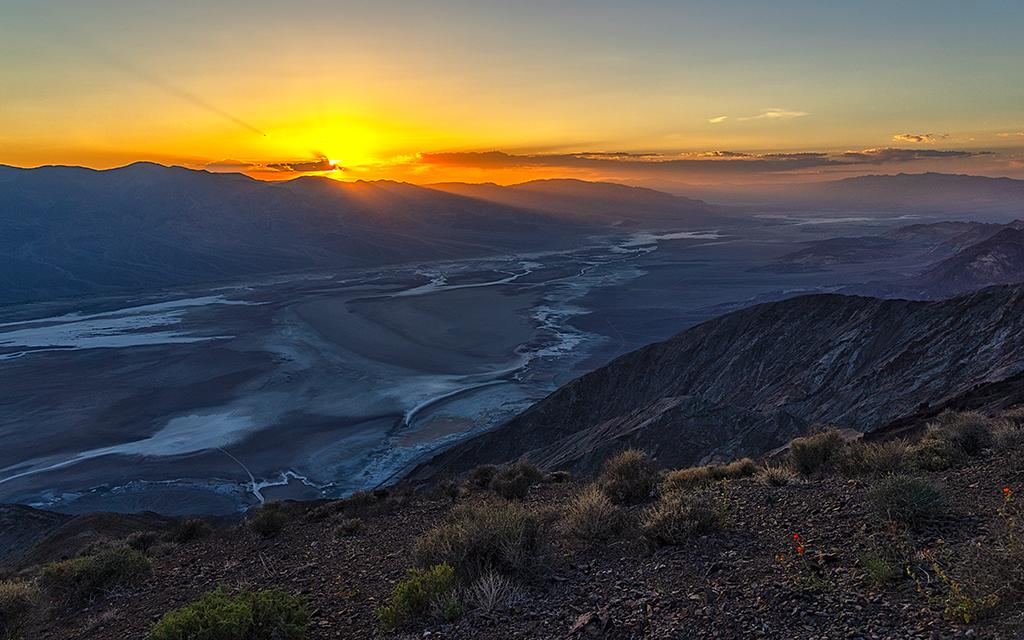
Sunset at Dantes View, Death Valley National Park / Rebecca Latson
These three parks possess divergent ecosystems, landscapes, wildlife, and geology. The photo ops are too numerous to count. Each is within a day’s driving distance from my home – ok, a couple of them a very long day’s drive but still doable. Ask me this question in another 11 years and see if my answer changes.
NPT: Do you have a checklist to ensure you take all the necessary photo equipment with you on national park visits, and if so, what’s on that list?
Oh yeah, I’ve got more than one list. If you read my article about planning and travel, you already know what I pack for general travel.
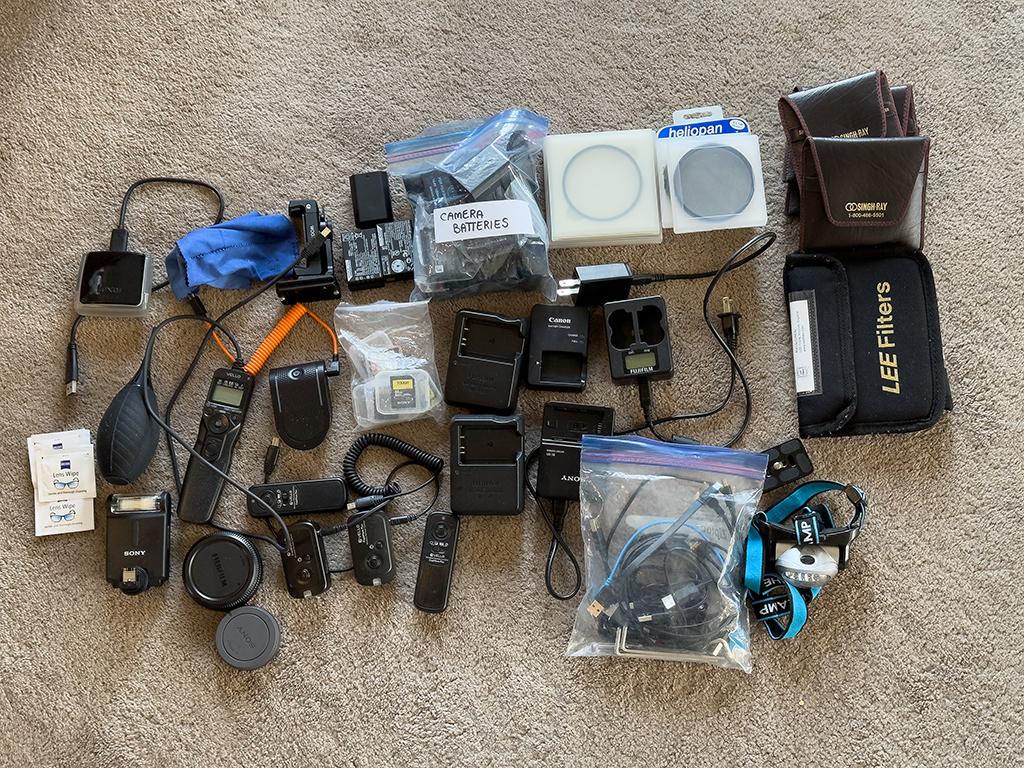
Photographic accessories all ready for a road trip / Rebecca Latson
Below is what I pack regarding camera gear.
If flying:
- 2-3 SLR camera bodies (detached from lenses) plus a point-and-shoot camera
- Wide-angle lens (either 14mm or 16-35mm)
- Standard zoom lens (24 – 70mm or 24-105mm)
- Telephoto lens (100-400mm)
- Tripod
- Graduated neutral density filter
- Circular polarizing filter
- UV filters (more for lens protection than anything else)
- Memory cards (plenty, so I won’t have to figure out which images to erase to make room for more because I forgot to bring enough cards)
- Spare camera batteries
- Laptop and cord
- Two portable hard drives (1 – 2 GB each) for storing the photos
- Camera battery chargers
- Smartphone charger (usually two, so I have one for the rental and one for my hotel room)
- Corded and cordless shutter remotes
- Lightning trigger for the camera – ok, this is a new item I haven’t tried out yet, and I’m hoping for a lightning storm or two over the Badlands to test the trigger. It fits on the camera hot shoe like a flash unit, so the trigger is small enough to pack.
- Microfiber cleaning cloths
- Rain/snow cover protection for my cameras (Vortex Media Storm Jacket, Think Tank, Ruggard)
- Zeiss-type lens cleaning packets for my reading glasses and camera lenses and filters
- Headlamp and flashlight(s) for night photography
- Safety glasses for windy, dusty days
The battery chargers and tripod fit into my checked luggage but everything else fits into my camera pack and laptop bag. FYI Airlines don’t allow you to pack lithium batteries into checked luggage.
If driving:
- Redundancy is a photographer’s best friend, so all the above plus extra lenses (all my lenses, if I so choose, since I have room for them). I might even rent a lens I don’t own, which is what I’ve done for this South Dakota trip. I’m hoping I might spy bison, pronghorn, prairie dogs, and other wildlife, so I’ve rented a Sony 200-600mm telephoto lens from a place called Lensrentals. I’ve utilized this company for camera and lens rentals before and know they are reliable.
- Two tripods (that redundancy thing) - I’ve had one break on me during a trip, so an extra is handy. I try to pack one lightweight tripod and one sturdier, heavier tripod to withstand any intense winds encountered (I hear it can get windy in the Badlands).
- Extra camera backpacks in different sizes for hiking or simply for cushioning the extra camera gear I choose to bring. For example, if I’m going on a day hike to photograph landscapes in a specific area, I’ll eschew the 100-400mm lens and use a smaller, lighter camera pack.
- Photo accessories I probably wouldn’t pack when flying, such as my fluid head tripod mount for smooth panoramas and videos, or my Platypod compact tripod for hard-to-reach spots not conducive to a full tripod setup. I might or might not use these items, but at least they are within handy reach.
Comparing this newly-minted article to that 2013 article brings into focus just how much my photographic viewpoint has changed with time. Your own photographic viewpoints have probably changed with time, too. And that’s good! When visiting a national park with your camera(s), you should always keep those views fresh. Be open to trying new things. Revisit your thoughts on existing things and see where you stand. Flexibility is key to improving those photographic talents so you can continue wowing your viewing audience with great shots of your national park visits.


